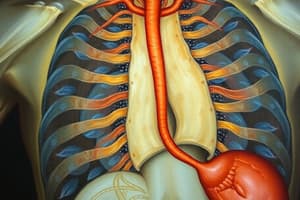Podcast
Questions and Answers
What is the normal range of portal pressure in mmHg?
What is the normal range of portal pressure in mmHg?
- 5-10 mmHg (correct)
- 5-8 mmHg
- 15-20 mmHg
- 10-15 mmHg
What is the most common cause of portal hypertension?
What is the most common cause of portal hypertension?
- Blood clots in the portal vein
- Congenital abnormalities of the portal vein
- Cirrhosis (correct)
- Infection or inflammation of the portal vein
What is a consequence of portal hypertension?
What is a consequence of portal hypertension?
- Improved liver function
- Reduced abdominal pain
- Decreased risk of bleeding
- Development of collateral vessels (correct)
What is a common symptom of portal hypertension?
What is a common symptom of portal hypertension?
What is a diagnostic test used to visualize esophageal and gastric varices?
What is a diagnostic test used to visualize esophageal and gastric varices?
What is a pharmacological therapy used to reduce portal pressure?
What is a pharmacological therapy used to reduce portal pressure?
What is a surgical procedure used to create a shunt between the portal vein and hepatic vein?
What is a surgical procedure used to create a shunt between the portal vein and hepatic vein?
What is a complication of portal hypertension?
What is a complication of portal hypertension?
Flashcards are hidden until you start studying
Study Notes
Definition and Pathophysiology
- Portal hypertension is a condition characterized by increased pressure in the portal vein, which carries blood from the digestive organs to the liver.
- Normal portal pressure: 5-10 mmHg
- Portal hypertension: >12 mmHg
- Causes:
- Cirrhosis (most common cause)
- Blood clots in the portal vein
- Infection or inflammation of the portal vein
- Congenital abnormalities of the portal vein
Consequences of Portal Hypertension
- Portal vein dilation
- Development of collateral vessels (e.g., esophageal varices, gastric varices)
- Increased risk of bleeding from these vessels
- Ascites (fluid accumulation in the abdominal cavity)
- Hepatic encephalopathy (brain dysfunction due to liver failure)
Clinical Features
- Symptoms:
- Abdominal pain and distension
- Nausea and vomiting
- Fatigue
- Diarrhea
- Signs:
- Palpable spleen
- Ascites
- Caput medusae (dilated veins around the umbilicus)
- Gastrointestinal bleeding
Diagnostic Tests
- Endoscopy: to visualize esophageal and gastric varices
- Imaging studies:
- Ultrasound: to assess liver and portal vein anatomy
- CT or MRI: to evaluate portal vein patency and liver disease
- Measurement of portal pressure: using hepatic venous pressure gradient (HVPG) or portal venous pressure
Management
- Treatment of underlying liver disease (e.g., cirrhosis)
- Endoscopic therapy: banding or sclerotherapy to treat esophageal varices
- Pharmacological therapy: beta blockers, nitrates, and somatostatin analogs to reduce portal pressure
- Transjugular intrahepatic portosystemic shunt (TIPS): a procedure to create a shunt between the portal vein and hepatic vein
- Liver transplantation: in severe cases of portal hypertension and liver failure
Portal Hypertension
- Characterized by increased pressure in the portal vein, which carries blood from digestive organs to the liver
- Normal portal pressure: 5-10 mmHg
- Portal hypertension: >12 mmHg
Causes of Portal Hypertension
- Cirrhosis: most common cause
- Blood clots in the portal vein
- Infection or inflammation of the portal vein
- Congenital abnormalities of the portal vein
Consequences of Portal Hypertension
- Portal vein dilation
- Development of collateral vessels, such as:
- Esophageal varices
- Gastric varices
- Increased risk of bleeding from these vessels
- Ascites: fluid accumulation in the abdominal cavity
- Hepatic encephalopathy: brain dysfunction due to liver failure
Clinical Features of Portal Hypertension
- Symptoms:
- Abdominal pain and distension
- Nausea and vomiting
- Fatigue
- Diarrhea
- Signs:
- Palpable spleen
- Ascites
- Caput medusae: dilated veins around the umbilicus
- Gastrointestinal bleeding
Diagnostic Tests for Portal Hypertension
- Endoscopy: to visualize esophageal and gastric varices
- Imaging studies:
- Ultrasound: to assess liver and portal vein anatomy
- CT or MRI: to evaluate portal vein patency and liver disease
- Measurement of portal pressure:
- Hepatic venous pressure gradient (HVPG)
- Portal venous pressure
Management of Portal Hypertension
- Treatment of underlying liver disease, such as cirrhosis
- Endoscopic therapy:
- Banding
- Sclerotherapy to treat esophageal varices
- Pharmacological therapy:
- Beta blockers
- Nitrates
- Somatostatin analogs to reduce portal pressure
- Transjugular intrahepatic portosystemic shunt (TIPS): a procedure to create a shunt between the portal vein and hepatic vein
- Liver transplantation: in severe cases of portal hypertension and liver failure
Studying That Suits You
Use AI to generate personalized quizzes and flashcards to suit your learning preferences.




